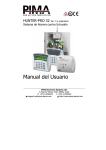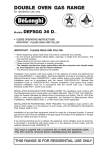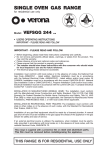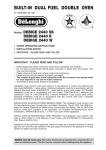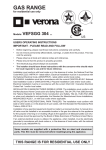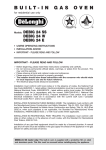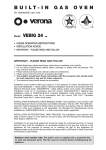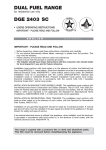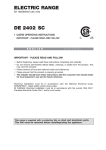Download Avanti DG 2401 C Operating instructions
Transcript
GAS RANGE for residential use only DG 2401 C • USERS OPERATING INSTRUCTIONS IMPORTANT - PLEASE READ AND FOLLOW E N G L I S H E S PA Ñ O L IMPORTANT - PLEASE READ AND FOLLOW ✓ Before beginning, please read these instructions completely and carefully. ✓ Do not remove permanently affixed labels, warnings, or plates from the product. This may void the warranty. ✓ Please observe all local and national codes and ordinances. ✓ Please ensure that this product is properly grounded. ✓ The installer should leave these instructions with the consumer who should retain for local inspector's use and for future reference. ✓ The electrical plug should always be accessible Installation must conform with local codes or in the absence of codes, the National Fuel Gas Code ANSIZ223.1 - Iatest edition. Electrical installation must be in accordance with the National Electrical Code, ANSI/NFPA70 - latest edition and/or local codes. IN CANADA: Installation must be in accordance with the current CAN/CGA-B149.1 National Gas Installation Code or CAN/CGA-B149.2, Propane Installation Code and/or local codes. Electrical installation must be in accordance with the current CSA C22.1 Canadian Electrical Codes Part 1 and/or local codes. INSTALLATION IN MANUFACTURED (MOBILE) HOME: The installation must conform with the Manufactured Home Construction and Safety Standard, Title 24 CFR, Part 3280 [formerly the Federal Standard for Mobile Home Construction and Safety, Title 24, HUD (Part 280)] or, when such standard is not applicable, the Standard for Manufactured Home Installations, ANSI/NCSBCS A225.1, or with local codes where applicable. INSTALLATION IN RECREATIONAL PARK TRAILERS: The installation must conform with state or other codes or, in the absence of such codes, with the Standard for Recreational Park Trailers, ANSI A119.5. Installation of any gas-fired equipment should be made by a Iicensed plumber. A manual gas shut-off valve must be installed in the gas supply line ahead of the appliance in the gas stream for safety and ease of service. If an external electrical source is utilized, the appliance, when installed, must be electrically grounded in accordance with local codes or, in the absence of local codes, with the national Electrical Code, ANSI/NFPA 70. This range is supplied with a protective film on steel and aluminium parts. This film must be removed before installing/using the appliance. WARNING • ALL RANGES CAN TIP • INJURY TO PERSON COULD RESULT • INSTALL ANTI-TIP DEVICE PACKED WITH RANGE • SEE INSTALLATION INSTRUCTIONS WARNING: IF THE INFORMATION IN THIS MANUAL IS NOT FOLLOWED EXACTLY, A FIRE OR EXPLOSION MAY RESULT CAUSING PROPERTY DAMAGE, PERSONAL INJURY, OR DEATH. ✓ Do not store or use gasoline or other flammable vapors and liquids in the vicinity of this or any other appliance. ✓ WHAT TO DO IF YOU SMELL GAS: • Do not try to light any appliance. • Do not touch any electrical switch; do not use any phone in your building. • lmmediately call your gas supplier from a neighbor's phone. Follow the gas supplier's instructions. • lf you cannot reach your gas supplier, call the fire department. ✓ Installation and service must be performed by a qualified installer, service agency, or the gas supplier. 2 Dear Customer, Thank you for having purchased and given your preference to our product. The safety precautions and recommendations reported below are for your own safety and that of others. They will also provide a means by which to make full use of the features offered by your appliance. Please preserve this booklet carefully. It may be useful in future, either to yourself or to others in the event that doubts should arise relating to its operation. This appliance must be used only for the task it has explicitly been designed for, that is for cooking foodstuffs. Any other form of usage is to be considered as inappropriate and therefore dangerous. The manufacturer declines all responsibility in the event of damage caused by improper, incorrect or illogical use of the appliance. 3 USER INSTRUCTIONS GENERAL INFORMATION WARNING!! 1. This appliance shall not be used for space heating. This information is based on safety considerations. WARNING!! ELECTRICAL GROUNDING INSTRUCTIONS 2. AlI openings in the wall behind the appliance and in the floor under the appliance shall be sealed. The range must be electrically grounded in accordance with local codes or, in the absence of local codes, with the National Electrical Code, ANSI/NFPA No. 70-latest edition. Installation should be made by a Iicensed electrician. 3. Keep appliance area clear and free from combustible materials, gasoline, and other flammable vapors. FOR PERSONAL SAFETY, THIS APPLIANCE MUST BE PROPERLY GROUNDED. 4. Do not obstruct the flow of combustion and ventilation air. If an external electrical source is utilized, the installation must be electrically grounded in accordance with local codes or, in the absence of local codes, with the national Electrical Code, ANSI/NFPA 70. 5. Disconnect the electrical supply to the appliance before servicing. 6. When removing appliance for cleaning and/or service; A. Shut off gas at main supply. B. Disconnect AC power supply. C. Disconnect gas line to the inlet pipe. D. Carefully remove the range by pulling outward. CAUTION: Range is heavy; use care in handling. This appliance is equipped with a three-prong grounding plug for your protection against shock hazard and should be plugged directly into a properly grounded socket. Do not cut or remove the grounding prong from the plug. Do not under any circumstances cut or remove the third (ground) prong from the power plug. 7. Electrical Requirement Electrical installation should comply with national and local codes. REPLACEMENT PARTS 8. Air Supply and Ventilation The installer must refers to local/national codes. 9. Gas Manifold Pressure Natural gas - 4.0” W.C.P. LP/Propane - 11.0” W.C.P. 10. The misuse of oven door (e.g. stepping, sitting, or leaning on them) can result in potential hazards and/or injuries. 11. When installing or removing the range for service, a rolling lift jack should be used. Do not push against any of the edges of the range in an attempt to slide it into or out of the installation. Pushing or pulling a range (rather than using a lift jack) also increases the possibility of bending the leg spindles or the internal coupling connectors. 4 Only authorized replacement parts may be used in performing service on the range. Replacement parts are available from factory authorized parts distributors. Contact the nearest AVANTI parts distributor in your area. IMPORTANT PRECAUTIONS AND RECOMMENDATIONS After having unpacked the appliance, check to ensure that it is not damaged. In case of doubt, do not use it and consult your supplier or a professionally qualified technician. Packing elements (i.e. plastic bags, polystyrene foam, nails, packing straps, etc.) should not be left around within easy reach of children, as these may cause serious injuries. . The packaging material is recyclable and is marked with the recycling symbol ✓ Do not attempt to modify the technical characteristics of the appliance as this may become dangerous to use. ✓ Do not carry out cleaning or maintenance operations on the appliance without having previously disconnected it from the electric power supply. ✓ After use, ensure that the knobs are in OFF position. ✓ Do not allow children or other incapable people to use the appliance without supervision. ✓ During and after use of the range, certain parts will become very hot. Do not touch hot parts. ✓ Keep children away from the range when it is in use. ✓ This range is supplied with a protective film on steel and aluminium parts. This film must be removed before installing/using the appliance. ✓ Fire risk! Do not store flammable material in the oven, and in the drawer. ✓ Make sure that electrical cables connecting other appliances in the proximity of the range cannot come into contact with the hob or become entrapped in the oven door. ✓ Do not line the oven walls with aluminium foil. Do not place shelves, grill-pan, pans or other cooking utensils on the base of the oven chamber. ✓ The manufacturer declines all liability for injury to persons or damage to property caused by incorrect or improper use of the appliance. ✓ To avoid any possible hazard, the appliance must be installed by qualified personnel only. Any repairs by unqualified persons may result in electric shock or short circuit. In order to avoid possible injuries to your body or to the appliance, do not attempt any repairs by yourself. Such work should be carried out by qualified service personnel only. ✓ Danger of burns! The oven and cooking accessories may become very hot during operation. Make sure children are kept out of reach and warn them accordingly. To avoid burns use kitchen clothes and gloves when handling hot parts or utensils. ✓ Stand away from the range when opening oven door. Hot air or steam which escapes can cause burns to hands, face, and/or eyes. ✓ Never clean the oven with a high-pressure steam cleaning device, as it may provoke a short circuit. ✓ This appliance is intended for use in your household. Never use the appliance for any other purpose! ✓ If you should decide not to use this appliance any longer (or decide to substitute an older model), before disposing of it, it is recommended that it be made inoperative in an appropriate manner in accordance to health and environmental protection regulations, ensuring in particular that all potentially hazardous parts be made harmless, especially in relation to children who could play with old appliances. Remove the door before disposal to prevent entrapment. IMPORTANT PRECAUTIONS AND RECOMMENDATIONS FOR USE OF ELECTRICAL APPLIANCES Use of any electrical appliance implies the necessity to follow a series of fundamental rules. In particular: ✓ Never touch the appliance with wet hands or feet; ✓ Do not operate the appliance barefooted; ✓ Do not allow children or disabled people to use the appliance without your supervision. The manufacturer cannot be held responsible for any damages caused by improper, incorrect or unreasonable use of the appliance. 5 features COOKING HOB 1. 2. 3. 4. 3 2 Auxiliary burner (AUX) - 3500 BTU/hr Left semi-rapid burner (SR) - 6000 BTU/hr Right semi-rapid burner (SR) - 6000 BTU/hr Triple-ring burner (TR) - 12000 BTU/hr Note: - The electric gas-lighting device is incorporated into the knobs. CAUTION: If the burner is accidentally extinguished, turn the gas off at the control knob and wait at least 1 minute before attempting to relight. 1 4 CAUTION: Gas appliances produce heat and humidity in the environment in which they are installed. Ensure that the cooking area is well ventilated following national/local codes. Fig. 1.1 CONTROL PANEL Fig. 1.2 9 10 11 5 6 7 8 CONTROLS DESCRIPTION Cooking hob controls: 5. Front left burner (1) control knob 6. Rear left burner (2) control knob 7. Rear right burner (3) control knob 8. Front right burner (4) control knob Oven controls: 9. Oven light switch control knob 10. Gas oven / gas broil burner control knob 11. Electronic clock/electronic alarm 6 how to use the top burners GAS BURNERS Gas flow to the burners is adjusted by turning the knobs (illustrated in fig. 2.1) which control the valves. Turning the knob so that the symbol printed on itself points to the symbols printed on the control panel achieves the following functions: = closed valve = maximum rate = minimum rate The maximum aperture position permits rapid boiling of liquids, whereas the minimum aperture position allows simmer warming of food or maintaining boiling conditions of liquids. To reduce the gas flow to minimum, rotate the knob further anti-clockwise to point the indicator towards the position. Other intermediate operating adjustments can be achieved by positioning the indicator between the maximum and minimum aperture positions, and never between the maximum aperture and positions. Fig. 2.1 N.B. When the range is not being used, set the gas knobs to their positions and also close the gas shut-off valve placed on the main gas supply line. LIGHTING GAS BURNERS In order to light the burner, you must: 1 – Turn the knob in an anti-clockwise direction up to the position (maximum rate), push in and hold the knob until the flame has been lit (fig. 2.2). The sparks produced by the lighter situated inside the relative burner will light the flame. In the event that the local gas supply conditions makes it difficult to light the burner in position, try again with the knob in position. If there is no mains electrical supply, bring a lighted match close to the burner. 2 – Adjust the gas valve to the desired position. Fig. 2.2 To re-light the burner, return the knob to the lighting. position and repeat the operations for Caution! The range becomes very hot during operation. Keep children well out of reach. 7 CHOICE OF BURNER (fig. 2.3) The symbols printed on the panel beside the gas knobs indicate the correspondence between the knob and the burner. The most suitable burner is to be chosen according to the diameter and volume capacity of the container to be warmed. It is important that the diameter of the pots or pans suitably match the heating potential of the burners in order not to jeopardise the efficiency of the burners, bringing about a waste of gas fuel. A small diameter pot or pan placed on a large burner does not necessarily mean that boiling conditions are reached quicker. Fig. 2.3 DIAMETERS OF PANS WHICH MAY BE USED ON THE HOB BURNERS BURNER MINIMUM MAX. Auxiliary 12 cm (4" 23/32 ) 14 cm (5" 1/2) Semirapid 16 cm (6" 19/64) 24 cm (9" 7/16) Triple-ring 26 cm (10" 15/64) 28 cm (11" 1/64) Wok pans max 36 cm (14" 11/64) Do not use pans with concave or convex bases WRONG CORRECT USE OF TRIPLE-RING BURNER (Fig. 2.4a - 2.4b) The flat-bottomed pans are to be placed directly onto the pan-support. Fig. 2.4a When using a WOK you need to place the supplied stand in the burner to avoid any faulty operation of the triple-ring burner (Fig. 2.4a - 2.4b). IMPORTANT: The special grille for wok pans (fig. 2.4b) MUST BE PLACED ONLY over the pan-rest for the triple-ring burner. CORRECT Fig. 2.4b Make sure that the handles of cookware do not stick out over the edge of the cooker, to avoid them being knocked over by accident. This also makes it more difficult for children to reach the cooking vessels. 8 how to use the gas oven GENERAL FEATURES The gas oven is provided with two burners: a) Oven burner, mounted on the lower part of the oven (13000 BTU/hr) b) Broil burner, mounted on the upper part of the oven (8500 BTU/hr). Attention: the range becomes very hot during operation. Attention: the oven door becomes very hot during operation. Keep children away. WARNING: The door is hot, use the handle. USING THE OVEN FOR THE FIRST TIME It is advised to follow these instructions: – Furnish the interior of the oven by placing the wire racks as described at chapter “Cleaning and maintenance”. – Insert shelves and tray. – Turn the oven on to the maximum temperature (position ) to eliminate possible traces of grease from the oven burner. The same operation should be followed for broil burner. – Switch off the electrical supply, let the oven cool down, then clean the interior of the oven with cloth soaked in water and detergent (neutral) then dry carefully. OVEN BURNER It carries out normal “oven cooking”. The gas flow to the burner is regulated by a thermostat which allow to maintain the oven temperature constant. The control of the temperature is assured by a thermostatic probe positioned inside the oven. The probe must be always kept in its housing, in a clean condition, as an incorrect position or encrustment may cause an alteration in the control of the temperature. Fig. 3.1 OVEN THERMOSTAT The numbers printed on the control knob (fig. 3.1) indicate the increasing oven temperature value (°F). To regulate the temperature, set the chosen number onto the control panel indicator. The position serves only to turn on the broil burner. N.B. When the range is not being used, set the gas knobs to their positions and also close the gas shut-off valve placed on the main gas supply line. GAS OVEN SETTING Number printed on the knob Temperature in °F Corresponding temperature in °C 200 93 250 121 300 149 350 177 400 204 450 232 500 260 550 288 9 IGNITION OF THE OVEN BURNER The thermostat allows the automatic control of the temperature. The gas delivery to the oven burner is controlled by a two way thermostatic tap (oven and broil burners) with flame-failure device. To light the oven burner operate as follows: 1) Open the oven door to its full extent. WARNING: Risk of explosion! The oven door must be open during this operation. 2) Lightly press and turn the thermostat knob anti-clockwise (fig. 3.2) to max position . Fig. 3.2 3) Press the knob right down to prime the electric ignition. Keep the knob pressed. In case of power cut, press the knob and immediately approach a lighted match to the opening “A” (fig. 3.3). Never continue this operation for more than 15 seconds. If the burner has still not ignited, wait for about 1 minute prior to repeating the ignition. 4) Wait about 10/15 seconds after the burner lighting before releasing the knob (time of priming of the valve). 5) Close the oven door slowly and adjust the burner according to the power required. If the flame extinguishes for any reason, the safety valve will automatically shut off the gas supply to the burner. To re-light the burner, first turn the oven control knob to position , wait for at least 1 minute and then repeat the lighting procedure. A Fig. 3.3 Attention: the oven door becomes very hot during operation. Keep children away. OVEN COOKING Before introducing the food, preheat the oven to the desired temperature. For a correct preheating operation, it is advisable to remove the tray from the oven and introduce it together with the food, when the oven has reached the desired temperature. Check the cooking time and turn off the oven 5 minutes before the theoretical time to recuperate the stored heat. 10 IGNITION OF THE BROIL BURNER The broil burner generates the infra-red rays for broiling. To light the broil burner operate as follow: 1) Open the oven door to the full extent. WARNING: Risk of explosion! The oven door must be open during this operation. 2) Lightly press and turn the thermostat knob clockwise to the position (fig. 3.4). 3) Press the knob right down to prime the electric ignition. Keep the knob pressed. In case of power cut, press the knob and put a lighted match to the right and left side of the burner (fig. 3.5). Never continue this operation for more than 15 seconds. If the burner has still not ignited, wait for about 1 minute prior to repeating the ignition. 4) Wait about 10/15 seconds after the burner lighting before releasing the knob (time of priming of the valve). 5) Close the oven door slowly. Fig. 3.4 If the flame extinguishes for any reason, the safety valve will automatically shut off the gas supply to the burner. To re-light the burner, first turn the oven control knob to position , wait for at least 1 minute and then repeat the lighting procedure. Do always broil with oven door closed. Attention: the oven door becomes very hot during operation. Keep children away. Fig. 3.5 OVEN LIGHT The range is equipped with a light that illuminates the oven to enable visually controlling the food that is cooking. This light is controlled by a switch knob (Fig. 3.6). To light the oven lamp turn the knob clockwise to position. Fig. 3.6 11 1° STEP Do not use 2° STEP Broiling level 3° STEP Oven cooking level 4° STEP Oven cooking level Fig. 3.7 BROILING Very important: the broil burner must always be used with the oven door closed. - Position the shelf on the second level from the top (fig. 3.7). - Turn on the broil burner, as explained in the preceding paragraphs and let the broil burner preheat for about 5 minutes with the door closed. - Place the food to be cooked above the grill-pan grid. - Introduce the grill-pan (tray + grid) in the oven (fig. 3.8). The grill-pan should be placed above the shelf and it should be centered with the broil burner (fig. 3.7). Fig. 3.8 Do not broil without using the grill pan. Important: Use always special handles supplied with the appliance to insert/remove the grill-pan from the oven (figs. 3.8, 3.9, 3.10, 3.11, 3.12, 3.13). CORRECT WRONG WRONG 1 Fig. 3.12 Fig. 3.10 Fig. 3.9 WRONG WRONG 2 Fig. 3.11 12 Fig. 3.13 electronic clock /electronic alarm ELECTRONIC CLOCK (fig. 4.1) The electronic alarm is a device which groups the functions of 12 hours clock with illuminated display and 10 hours alarm. Upon immediate connection of the range or after a blackout, 12•00 will flash on the display. To set the hour it is necessary to push the button and then, within 7 seconds, the or button until you have set the exact hour. An energy black-out makes the clock go to zero. SET TIME OF DAY Push button and then, within 7 seconds, the or button until you have set the exact hour. This function remains activated 7 seconds after the last pushing of or button. Change the hours only: press the button for 4 seconds until the hours display will flash. Change the hours only by pushing the or button. The minutes and hidden seconds will not be affected. Fig. 4.1 ELECTRONIC ALARM The alarm program consists only of a buzzer which may be set for a maximum period of 10 hours. To set the time, push the or button until you obtain the desired time in the display. From 0•10 to 99•50 you read the time in minutes and seconds (10 seconds step); then from 1•40 to 10•00 you read the time in hours and minutes (minutes step). Having finished the setting, the symbol will be lighted and the countdown will start immediately. During countdown the timer has priority in the display. To show the time of day press button. At the end of the time, the symbol will be switched off and an intermittent buzzer, during 7 minutes, will go off; this can be stopped by pressing the button. The signal will be skipped if button is pressed during the last 15 seconds of the timer. To stop the alarm countdown in any moment keep the 0•00 on the display (symbol switches off). button pressed until you read IMPORTANT WARNING: THIS IS ONLY AN ELECTRONIC ALARM. REMEMBER TO TURN OFF THE OVEN OR BROIL MANUALLY AT THE END OF COUNTDOWN. SETTING THE FREQUENCY OF THE ALARM SOUND The selection from 3 possibilities of sound can be made by pressing the button. 13 cleaning and maintenance WARNING Electrical Shock Hazard Plug into a grounded 3-prong outlet. Do not remove ground prong. Do not use an adapter. Failure to follow these instructions can result in death, fire, or electrical shock. 3-prong polarized ground-type outlet GENERAL RECOMANDATION ✓ Important: Before any operation of cleaning and maintenance disconnect the appliance from the electrical supply. ✓ It is advisable to clean when the appliance is cold and especially for cleaning the enamelled parts. ✓ Avoid leaving alkaline or acidic substances (lemon juice, vinegar, etc.) on the surfaces. ✓ Avoid using cleaning products with a chlorine or acidic base. The oven must always be cleaned after every use, using suitable products and keeping in mind that its operation for 30 minutes on the highest temperature eliminates most grime reducing it to ashes. ENAMELLED PARTS ✓ All the enamelled parts must be cleaned with a sponge and soapy water only or other non-abrasive products. Dry preferably with a chamois leather. STAINLESS STEEL SURFACES (COATED) CAUTION ✓ The STAINLESS STEEL front surfaces used in this range are protected with a Special Lacquer to reduce finger-print marks. To avoid damaging this lacquer, do not clean the stainless steel with abrasive cleaners or abrasive cloths or scouring pads. ONLY SOAP/WARM WATER MUST BE USED TO CLEAN THE STAINLESS STEEL SURFACES. STAINLESS STEEL SURFACES (UNCOATED) ground prong The hob + sides are made from uncoated stainless steel. Can be cleaned with an appropriate stainless steel cleaner. INSIDE OF OVEN This must be cleaned regularly. With the oven warm, wipe the inside walls with a cloth soaked in very hot soapy water or another suitable product. WARNING VERY IMPORTANT Before any operation of maintenance disconnect the appliance from the electrical mains supply. 14 Do not use steam jet cleaners because the humidity could infiltrate into the appliance making it dangerous. BURNERS AND GRIDS ✓ These parts can be removed and cleaned with appropriate products. ✓ After cleaning, the burners and their flame distributors must be well dried and correctly replaced. ✓ It is very important to check that the burner flame distributor and the cap has been correctly positioned - failure to do so can cause serious problems. ✓ In appliances with electric ignition keep the electrode clean so that the sparks always strike. ✓ Note: To avoid damage to the electric ignition do not use it when the burners are not in place. CORRECT REPLACEMENT OF THE BURNERS It is very important to check that the burner flame spreader “F” and the cap “C” have been correctly positioned (see figs. 5.1 and 5.2 ). Failure to do so can cause serious problems. In appliances with electric ignition, check that the electrode “S” (fig. 5.1) is always clean to ensure trouble-free sparking. C F The ignition plug must be very carefully cleaned. S Fig. 5.1 Fig. 5.2 CORRECT POSITION OF TRIPLE RING BURNER The triple ring burner must be correctly positioned (see fig. 5.3); the burner rib must be fitted in their housing as shown by the arrow. The burner correctly positioned must not rotate (fig. 5.4). Then position the cap A and the ring B (fig. 5.4 - 5.5). Fig. 5.3 A B GAS VALVES ✓ In the event of operating faults in the gas valves, call the Service Department. Fig. 5.4 Fig. 5.5 15 OVEN ACCESSORIES INSTALLATION AND REMOVAL – Hang up the wire racks “G” on the oven walls (fig. 5.6). G – Slide in, on the guides, the shelf etc. (fig. 5.7). The rack must be fitted so that the safety catch, which stops it sliding out, faces the inside of the oven. – Position the grill-pan (tray + grid) above the oven shelf. – To dismantle, operate in reverse order. Fig. 5.6 Do not use this step Safety catch Fig. 5.7 OVEN DOOR AND DRAWER The internal glass of the oven door can be easily removed for cleaning by unscrewing the two lateral fixing screws (fig. 5.8). The drawer (fig. 5.9) comes out like a normal drawer. A safety catch stops it from sliding out. To remove the drawer open and lift it. Do not store flammable material in the oven or in the drawer. Fig. 5.8 REPLACING THE OVEN LIGHT Before any maintenance is started involving electrical parts of the appliance, it must be disconnected from the power supply. – – – – Let the oven cavity and the broil burner cool down; Switch off the electrical supply; Remove the protective cover; Unscrew and replace the bulb with a new one suitable for high temperatures (300°C570°F) having the following specifications: 120V 60 Hz, 15W, E14 – Refit the protective cover NOTE: Oven bulb replacement is not covered by your guarantee Fig. 5.9 16 REMOVING THE OVEN DOOR Type A To facilitate oven cleaning, it is possible to remove the door. Please follow the instructions carefully: – Open the door completely. – Push down the lever “L” and, keeping it in this position, slowly close the door in order to block the hinge (fig. 5.10). – Grip the door (as indicated in fig. 5.11) and, while closing it, release the two hinges as shown in fig. 5.12. – Rest the door on a soft surface. L Fig. 5.10 DOOR ASSEMBLY – Grip the door with your hands placed near the hinges and raise the levers “H” with your forefingers (fig. 5.12) – Insert the hinges in their position until levers “H” are hooked. – Open the door completely to obtain the release of levers “L”. Fig. 5.11 H Fig. 5.12 REMOVING THE OVEN DOOR Fig. 5.13A Type B The oven door can easily be removed as follows: – Open the door to the full extent (fig. 5.13A). – Attach the retaining rings to the hooks on the left and right hinges (fig. 5.13B). – Hold the door as shown in fig. 5.13. – Gently close the door and withdraw the lower hinge pins from their location (fig. 5.13C). Fig. 5.13B – Withdraw the upper hinge pins from their location (fig. 5.13D). – Rest the door on a soft surface. – To replace the door, repeat the above steps in reverse order. Fig. 5.13C Fig. 5.13D Fig. 5.13 17 DO’S AND DO NOT’S • Do always broil with the oven door closed. • Do read the user instructions carefully before using the range for first time. • Do allow the oven to heat for one and a half hours, before using for the first time, in order to expel any smell from the new oven insulation, without the introduction of food. • Do clean your oven regularly. • Do remove spills as soon as they occur. • Do always use oven gloves when removing food shelves and trays from the oven. • Do not allow children near the range when in use. • Do not allow fat or oils to build up in the oven base, or oven accessories. • Do not place cooking utensils or plates directly onto the oven base. • Do not broil without using the grill-pan. • Do not place hot enamel parts in water. Leave them to cool first. • Do not allow vinegar, coffee, milk, saltwater, lemon or tomato juice to remain in contact with enamel parts (i.e. inside the oven). • Do not use abrasive cleaners or powders that will scratch the surface of the stainless steel and the enamel. • Do not attempt to repair the internal workings of your range. • Do remove the protective film before the first use. • Fire risk! Do not store flammable material in the oven and in the drawer. FOR YOUR SAFETY Under no circumstances should any external covers be removed for servicing or maintenance except by suitably qualified personnel 18 warranty WARRANTY – GAS RANGE LENGTH OF WARRANTY WE WILL PAY FOR FULL ONE-YEAR WARRANTY FROM DATE OF PURCHASE ON ALL PARTS EXCEPT GLASS PARTS IN RENTAL OR COMMERCIAL USE, THE WARRANTY PERIOD IS 90 DAYS. REPLACEMENT PARTS AND REPAIR LABOR TO CORRECT DEFECTS IN MATERIALS OR WORKMANSHIP. SERVICE MUST BE PROVIDED BY AN AUTHORIZED SERVICE COMPANY. FULL 30-DAY WARRANTY FROM DATE OF PURCHASE ON GLASS PARTS AND FINISH OF PORCELAIN ENAMEL, PAINTED OR BRIGHT METAL FINISHED PARTS. REPLACEMENT PARTS AND REPAIR LABOR TO CORRECT DEFECTS IN MATERIAL OR WORKMANSHIP. SERVICE MUST BE PROVIDED BY AN AUTHORIZED SERVICE COMPANY. WE WILL NOT PAY FOR A. Service calls to: 1. Correct the installation of your range. 2. Instruct you how to use your range. 3. Replace house fuses or correct house wiring. 4. Replace owner-accessible light bulbs. B. Pickup and delivery. Your range is designed to be repaired in the home. C. Damage to your range caused by accident, misuse, fire, flood, acts of God, or use of products not mentioned in this manual. D. Repairs to parts or systems caused as a result of unauthorized modifications made to the appliance. E. Repairs when your range is used in other than normal, single-family household use. AVANTI PRODUCTS SHALL NOT BE LIABLE FOR INCIDENTAL OR CONSEQUENTIAL DAMAGES. Some states do not allow the exclusion or limitation of incidental or consequential damages, so this exclusion or limitation may not apply to you. This warranty gives you specific legal rights, and you may also have other rights that vary from state to state. This warranty is not valid outside the Continental United States. The manufacturer cannot be held responsible for possible inaccuracies due to printing or transcription errors in the present booklet. The manufacturer reserves the right to make all modifications to its products deemed necessary for manufacture or commercial reasons at any moment and without prior notice, without jeopardising the essential functional and safety characteristics of the appliances. 19 COCINA A GAS para uso doméstico únicamente DG 2401 C • INSTRUCCIONES DE FUNCIONAMIENTO PARA USUARIOS IMPORTANTE – LE ROGAMOS LEER Y RESPETAR LO SIGUIENTE E N G L I S H E S PA Ñ O L IMPORTANTE - LEER CUIDADOSAMENTE ✓ Antes de iniciar, lea cuidadosamente todas las instrucciones. ✓ No extraiga las etiquetas pegadas, advertencias o placas que han sido aplicadas al aparato, ya que puede invalidar la garantía. ✓ Respete todos los códigos locales y nacionales vigentes. ✓ El aparato debe estar dotado de un adecuada puesta a tierra. ✓ El instalador debe dejar estas instrucciones al usuario que las debe guardar para el uso del inspector local y en caso de sucesivas consultas. ✓ La clavija de conexión debe estar siempre en una posición accesible. La instalación debe ser conforme a los códigos locales o en ausencia de códigos, con la última edición de "National Fuel Gas Code ANSIZ223.1". La instalación eléctrica se debe efectuar conforme con el "National Electrical Code", ANSI/NFPA70 - Última edición y/o demás códigos locales. EN CANADÁ: La instalación se debe efectuar de acuerdo con el actual "CAN/CGAB149.1 National Gas Installation Code or CAN/CGA-B149.2" Código de instalación de propano y/o demás códigos locales. La instalación eléctrica se debe efectuar de acuerdo con el actual "CSA C22.1 Canadian Electrical Codes Part 1" y/o demás códigos locales. INSTALACIÓN EN CASAS PREFABRICADAS (MÓVILES): La instalación debe efectuarse en conformidad con "Home Construction and Safety Standard, Title 24 CFR, Part 3280" [anteriormente "Federal Standard for Mobile Home Construction and Safety, Title 24, HUD (Part 280)"] o, cuando dicha norma no sea aplicable, en conformidad con "Standard for Manufactured Home Installations, ANSI/NCSBCS A225.1", o con códigos locales cuando sea aplicable. INSTALACIÓN EN CARAVANAS DE PARQUES DE ATRACCIONES: la instalación debe efectuarse en conformidad con los códigos del estado u otros, en ausencia de dichos códigos, con el "Standard for Recreational Park Trailers, ANSI A119.5". La instalación de cualquier equipamiento alimentado con gas debe ser realizada por un plomero cualificado. Debe instalarse una válvula de cierre manual en la línea de suministro principal de gas situada antes del aparato en el flujo del gas para garantizar la seguridad y facilitar las operaciones de mantenimiento. Si se utiliza una fuente eléctrica externa, el aparato, durante la instalación, debe contar con una toma de tierra según establecen los códigos locales o, en ausencia de códigos locales, en conformidad con el "national Electrical Code, ANSI/NFPA 70". La cocina se suministra con una película de protección aplicada en las partes de acero y de aluminio. Quite la película antes de instalar/usar el aparato. ADVERTENCIA • TODAS LAS COCINAS PUEDEN VOLCARSE • PUEDEN CAUSAR DAÑOS A PERSONAS • INSTALAR EL DISPOSITIVO ANTIVUELCO EMBALADO CON LA COCINA • CONSULTAR LAS INSTRUCCIONES PARA LA INSTALACIÓN ADVERTENCIAS: SI LA INFORMACIÓN EN ESTE FOLLETO NO SE RESPETA EXACTAMENTE, SE PUEDEN PROVOCAR INCENDIOS O EXPLOSIONES CON DAÑOS, INCLUSIVE FATALES, A PERSONAS Y COSAS. ✓ No almacene o utilice gasolina u otros vapores y líquidos inflamables cerca de este o cualquier otro aparato. ✓ QUÉ HACER EN CASO DE FUGAS DE GAS: • No encienda ningún aparato. • No toque ningún interruptor eléctrico; no utilice ningún teléfono de su casa. • Llame inmediatamente a su proveedor de gas usando el teléfono de un vecino. Siga las instrucciones de su proveedor de gas. • Si no consigue contactar a su proveedor de gas, llame a los bomberos. ✓ La instalación y el mantenimiento deben ser efectuadas por un instalador cualificado, agencias de servicio o el proveedor de gas. 22 Estimado Cliente, Gracias por la confianza demostrada en la compra de nuestro producto. Las medidas de seguridad y consejos descritos están finalizados a proteger su seguridad y la del próximo. Permitirán también aprovechar al máximo las características de su aparato. Por lo tanto guarde este folleto cuidadosamente. Le podrá servir un futuro a Ud. o a los demás en caso de dudas relativas al funcionamiento del aparato. Este aparato se debe utilizar sólo para la finalidad expresa para la cual ha sido diseñado, es decir cocinar comida. Cualquier otro uso se debe considerar inapropiado y por lo tanto peligroso. El fabricante declina toda responsabilidad en caso de daños causados por uso impropio, incorrecto o irrazonable del aparato. 23 INSTRUCCIONES DE USO INFORMACIÓN GENERAL ¡¡CUIDADO!! 1. El aparato no debe ser utilizado como estufa, por motivos de seguridad. INSTRUCCIONES DE LA PUESTA A TIERRA 2. Todas las aberturas en la pared detrás del aparato y en el piso debajo del mismo se deberán sellar. La cocina debe contar con una toma de tierra eléctrica según los códigos locales o, en ausencia de códigos locales, en conformidad con el "National Electrical Code, ANSI/NFPA No. 70" - última edición. Un electricista cualificado debe realizar la instalación. 3. Mantenga el área del aparato despejada y libre de combustibles, gasolina o vapores inflamables. ESTE APARATO DEBE ESTAR DOTADO DE UNA ADECUADA PUESTA A TIERRA POR RAZONAS DE SEGURIDAD. 4. No tape el flujo de la combustión y el aire de ventilación. 5. Desconecte el suministro eléctrico del aparato antes de efectuar el mantenimiento. 6. Al retirar el aparato para efectuar su limpieza y/o el mantenimiento: A. Cierre el suministro de gas; B. Desconecte la alimentación de CA C. Desconecte el suministro de gas en la tubería de entrada. D. Levante con cuidado el aparato del espacio previsto en el mueble CUIDADO: Preste atención durante la manipulación. 7. Requisito Eléctrico La instalación eléctrica debe estar conforme con los códigos nacionales y locales. 8. Suministro de Aire y Ventilación El instalador debe atenerse a los códigos locales y nacionales. 9. Presión del Suministro de Gas Gas natural - 4.0” W.C.P. LP/Propano - 11.0” W.C.P. 10. El uso incorrecto de la puerta del horno (o sea pisarla, sentarse o apoyarse en ella) puede provocar riesgos potenciales y/o causar daños. 11. Durante la instalación o remoción de la cocina para repararla, use un gato elevador de rodillos. No empuje los bordes de la cocina para intentar deslizarla dentro o fuera de la instalación. Empujando o tirando de la cocina (en lugar de usar un gato elevador) aumentan también las posibilidades de doblar los pivotes de los pies o los conectores de acoplamiento internos. 24 ¡¡CUIDADO!! Si se utiliza una fuente eléctrica externa, la instalación debe contar con una toma de tierra según establecen los códigos locales o, en ausencia de códigos locales, en conformidad con el "national Electrical Code, ANSI/NFPA 70". Este aparato está dotado de una clavija tripolar con puesta a tierra y protección contra sacudidas y debe estar enchufada directamente a una toma con puesta a tierra No corte o extraiga la puesta a tierra de la clavija. Bajo ninguna razón corte o extraiga o corte el tercer terminal (tierra) de la clavija de conexión. SUSTITUCIÓN DE PARTES Se pueden usar únicamente recambios autorizados para la reparación de la cocina. Puede localizar los recambios en distribuidores de recambios autorizados. Póngase en contacto con el distribuidor de recambios AVANTI más cercano en su zona. RECOMENDACIONES Y PRECAUCIONES IMPORTANTES Tras haber desembalado el aparato, asegúrese de que no esté estropeado. En caso de duda, no lo use y consulte a su distribuidor o a un técnico cualificado profesional. No deje los elementos que componen el embalaje (e.j: bolsas de plástico, espuma de poliestireno, clavos, flejes, etc) al alcance de los niños ya que pueden causar graves daños. El material del embalaje es reciclable y está marcado con el símbolo de reciclaje . ✓ No intente modificar las características técnicas del aparato ya que puede resultar peligroso durante el uso. ✓ No efectúe operaciones de limpieza o mantenimiento en el aparato sin haberlo previamente desenchufado de la corriente. ✓ Después del uso, asegúrese de que los mandos estén en la posición OFF. ✓ No permita a niños o a personas discapacitadas usar el aparato sin supervisión. ✓ Durante y después del uso de la cocina, algunas partes se calientan enormemente. No toque las partes calientes. ✓ Mantenga a los niños alejados de la cocina cuando está funcionando. ✓ Esta cocina se suministra con una película de protección aplicada en las partes de aluminio y acero. Quite la película antes de instalar/usar el aparato. ✓ ¡Riesgo de incendio! No almacene material inflamable en el horno ni en el cajón. ✓ Asegúrese de que los cables eléctricos que conectan otros aparatos en las proximidades de la cocina no pueden entrar en contacto con la placa de la cocina o quedar atrapados en la puerta del horno. ✓ No forre las paredes del horno con papel de aluminio. No sitúe parrillas, bandeja para grasa, moldes u otros utensilios de cocina en la base de la cámara del horno. ✓ El fabricante declina cualquier responsabilidad por los daños causados a personas o por los desperfectos causados a cosas por un uso incorrecto o impropio del aparato. ✓ Para evitar cualquier posible riesgo, el aparato debe ser instalado por personal cualificado únicamente. Cualquier reparación realizada por personas no cualificadas puede producir una descarga eléctrica o un cortocircuito. Para evitar cualquier posible daño a su persona o al aparato, no intente efectuar reparaciones usted mismo. Dicho trabajo debe ser realizado por personal de mantenimiento cualificado únicamente. ✓ ¡Peligro de quemaduras! El horno y los accesorios de cocina pueden calentarse enormemente durante el funcionamiento. Asegúrese de que los niños permanezcan alejados y adviértalos de ello consecuentemente. Para evitar quemaduras, use ropa de cocina y guantes para tocar partes o utensilios calientes. ✓ Permanezca alejado de la cocina al abrir la puerta del horno. El aire caliente o vapor que sale puede quemarle las manos, la cara y/o los ojos. ✓ No limpie nunca el horno con un dispositivo de limpieza de alta presión ya que puede provocar un cortocircuito. ✓ Este aparato ha sido concebido para un uso doméstico. ¡No use nunca el aparato para otros fines! ✓ Si decide no usar más este aparato (o decide sustituir un modelo antiguo), antes de tirarlo, le aconsejamos hacer que sea inservible de forma adecuada en conformidad con las normas de protección medio ambiental y de la salud, garantizando en particular que todas las partes potencialmente peligrosas sean inocuas, especialmente en relación a niños que podrían jugar con aparatos viejos. Quite la puerta antes de la eliminación para evitar que alguien pueda quedar atrapado. PRECAUCIONES Y RECOMENDACIONES IMPORTANTES PARA USAR APARATOS ELÉCTRICOS Usar un aparato eléctrico requiere seguir una serie de reglas fundamentales. En particular: ✓ No toque nunca el aparato con las manos o los pies mojados; ✓ No haga funcionar el aparato descalzo; ✓ No permita que niños o personas discapacitadas usen el aparato sin su supervisión. El fabricante no puede ser considerado responsable por cualquier daño causado por un uso impropio, incorrecto o irracional del aparato. 25 características PLACA DE COCCIÓN 1. 2. 3. 4. 3 2 Quemador auxiliar (AUX) - 3500 BTU/hr Quemador semirrápido izquierdo (SR) - 6000 BTU/hr Quemador semirrápido derecho (SR) - 6000 BTU/hr Quemador de tres filas (TR) - 12000 BTU/hr Notas: - El dispositivo de encendido eléctrico del está incorporado en los botones. CUIDADO: Si el quemador se apaga accidentalmente, apague la placa por medio del botón y espere almenos 1 minutos antes de encenderla de nuevo. 1 4 CUIDADO: Las placas de cocción a gas generan calor y humedad en el ambiente en donde se han instalado. Compruebe que la zona de cocción esté bien ventilada conforme con los códigos nacionales y locales. Fig. 1.1 PANEL DE CONTROL Fig. 1.2 9 10 11 5 6 7 8 DESCRIPCIÓN DE LOS MANDOS Mandos de la placa 5. Mando (1) quemador izquierdo delantero 6. Mando (2) quemador izquierdo trasero 7. Mando (3) quemador derecho trasero 8. Mando (4) quemador derecho delantero Mandos del horno: 9. Mando botón luz del horno 10. Mando quemador grill gas/horno a gas 11. Alarma electrónica /reloj electrónico 26 cómo usar los quemadores de la placa QUEMADORES DE GAS El flujo de gas que llega a los quemadores se regula girando los mandos (ilustrados en la fig. 2.1) que controlan las válvulas. Al girar el mando para que el símbolo imprimido en el mismo mando coincida con el símbolo imprimido en el panel de control se producen las siguientes funciones: = válvula cerrada = caudal máximo = caudal mínimo La posición de máxima abertura permite hacer hervir rápidamente los líquidos; mientras que la posición de abertura mínima permite calentar los alimentos o mantener los líquidos hirviendo. Para disminuir el caudal del gas al mínimo, gire el mando ulteriormente en el sentido antihorario para situar el indicador orientado hacia la posición . Otras regulaciones intermedias de funcionamiento pueden realizarse situando el indicador entre las posiciones de máxima y mínima abertura pero nunca entre las aberturas de máxima y posiciones de . Fig. 2.1 N.B. Cuando no use la cocina, sitúe los mandos del gas en sus posiciones y cierre también la válvula de cierre del gas situada en la línea de suministro del gas principal. ENCENDIDO DE LOS QUEMADORES DE GAS Para encender un quemador, es necesario: 1 – Girar el botón en sentido antihorario en correspondencia de la posición (potencia máxima), mantener presionando el botón hasta encender el fuego (fig. 2.2). Las chispas producidas por el mechero situado en el quemador correspondiente encienda la llama. En caso de que las condiciones del proveedor local de gas dificulten el encendido del quemador en la posición , repita la operación con el botón en correspondencia de la posición . En caso de corte del suministro eléctrico, acerque un fósforo encendido al quemador. Fig. 2.2 2 – Regule la válvula de gas a la posición deseada. Para reencender el quemador, lleve el botón a la posición de encendido. y repita las operaciones Cuidado! La cocina se recalienta durante el funcionamiento. Mantenga a los niños fuera del alcance 27 ELECCIÓN DEL QUEMADOR Fig. 2.3 (fig. 2.3) Los símbolos impresos en el panel al lado de los botones del gas indican la correspondencia entre el botón y el quemador. El quemador más adecuado se debe seleccionar de acuerdo con el diámetro y la capacidad de la cacerola que calentará. Es importante que el diámetro de las cacerolas o sartenes sean adecuadas a la potencia de calentamiento de los quemadores para no comprometer la eficiencia de los quemadores, produciendo un derroche de gas. Una cacerola de diámetro pequeño o un sartén puesta sobre un quemador grande no significa necesariamente que su contenido alcanzará la ebullición de manera más rápida. DIÁMETROS DE CAZUELAS QUE PUEDEN USARSE EN LOS QUEMADORES DE LA PLACA QUEMADOR MÍNIMO MÁX.. Auxiliar 12 cm (4" 23/32 ) 14 cm (5" 1/2) Semirrápido 16 cm (6" 19/64) 24 cm (9" 7/16) Tres filas 26 cm (10" 15/64) 28 cm (11" 1/64) Cazuelas wok máx 36 cm (14" 11/64) No use cazuelas con bases cóncavas o convexas. INCORRECTO USO CORRECTO DEL QUEMADOR DE TRES FILAS (Fig. 2.4a - 2.4b) Fig. 2.4a Las cazuelas con fondo plano deben situarse directamente sobre el soporte-cazuela. Si usa un WOK debe situar el soporte suministrado en el quemador para evitar cualquier funcionamiento incorrecto del quemador de triple fila (Fig. 2.4a - 2.4b). IMPORTANTE: COLOQUE ÚNICAMENTE la rejilla especial para cazuela wok (fig. 2.4) sobre el apoyo cazuela para el quemador de triple fila. CORRECTO Fig. 2.4b Asegúrese de que los mangos de los utensilios usados en la cocina no sobresalgan del borde de la cocina para evitar chocar contra ellos accidentalmente. Lo cual dificulta que los niños puedan acceder a los recipientes de cocina. 28 cómo usar el horno a gas CARACTERÍSTICAS GENERALES El horno a gas está equipado con dos quemadores: a) Quemador del horno, montado en la parte inferior del horno (13000 BTU/hr), b) Quemador del grill, montado en la parte superior del horno (8500 BTU/hr). Atención: la cocina se pone muy caliente durante el funcionamiento. Atención: la puerta del horno se pone muy caliente durante el funcionamiento. Mantenga a los niños alejados. USAR EL HORNO POR PRIMERA VEZ ADVERTENCIA: La puerta está caliente, use el tirador. Le aconsejamos seguir las siguientes instrucciones: – Equipe el interior del horno situando las parrillas laterales siguiendo las indicaciones facilitadas en el capítulo “Limpieza y mantenimiento”. – Coloque las parrillas y bandeja. – Encienda el horno con la máxima temperatura (posición ) para eliminar los posibles restos de grasa en el quemador del horno. Efectúe la misma operación para el quemador del horno. – Interrumpa el suministro de corriente, deje que el horno se enfríe, a continuación limpie el interior del horno con un paño embebido con agua y detergente (neutro) y seque meticulosamente a continuación. QUEMADOR DEL HORNO Sirve para "hornear" normalmente. El caudal del gas que llega al quemador está regulado mediante un termostato que permite mantener la temperatura del horno constante. El control de la temperatura está garantizado mediante una sonda termostática situada dentro del horno. Mantenga siempre la sonda en su alojamiento, en un estado limpio, ya que una posición incorrecta o incrustaciones puede causar una alteración en el control de la temperatura. Fig. 3.1 TERMOSTATO DEL HORNO Los números imprimidos en el mando (fig. 3.1) indican el valor de temperatura del horno en aumento (°F). Para regular la temperatura, programe el número elegido en el indicador del panel de control. La posición sirve únicamente para encender el quemador del grill. N.B. Cuando no use la cocina, sitúe los mandos del gas en sus posiciones de y cierre también la válvula de cierre situada en la línea de suministro de gas principal. PROGRAMACIÓN HORNO A GAS Número imprimido Temperatura en el mando correspondiente en Temperatura en °C °F 200 93 250 121 300 149 350 177 400 204 450 232 500 260 550 288 29 ENCENDIDO DEL QUEMADOR DEL HORNO El termostato permite efectuar un control automático de la temperatura. El suministro de gas al quemador del horno está controlado mediante dos grifos termostáticos de dos vías (quemadores para horno y grill) con dispositivo de apagado llama. Para encender el quemador del horno, efectúe las siguientes operaciones: 1) Abra la puerta del horno completamente. ADVERTENCIA: ¡Riesgo de explosión! Abra la puerta del horno durante esta operación. 2) Presione ligeramente y gire el mando del termostato en el sentido antihorario (fig. 3.2) hasta la posición máx. . Fig. 3.2 3) Presione el mando completamente para preparar el encendido eléctrico. Mantenga este mando presionado. En caso de interrupción de corriente, presione el mando y acerque una cerilla encendida a la abertura A (fig. 3.3). No efectúe esta operación durante más de 15 segundos. Si el quemador sigue sin encenderse, espere un 1 minuto antes de repetir el encendido. 4) Espere 10/15 segundos aproximadamente después de encender el quemador antes de soltar el mando (tiempo de preparación de la válvula). 5) Cierre la puerta del horno lentamente y regule el quemador según la potencia requerida. Si la llama se apaga por cualquier razón, la válvula de seguridad interrumpirá automáticamente el suministro del gas al quemador. A Para encender de nuevo el quemador, gire en primer lugar el mando del horno hasta la posición , espere por lo menos 1 minuto y repita el procedimiento de encendido. Fig. 3.3 Atención: la puerta del horno se pone muy caliente durante el funcionamiento. Mantenga a los niños alejados. HORNEAR Antes de introducir los alimentos, precaliente el horno hasta alcanzar la temperatura elegida. Para efectuar correctamente el precalentamiento, le aconsejamos sacar la bandeja del horno e introducirla junto con los alimentos en el horno cuando éste alcanza la temperatura elegida. Controle el tiempo de cocción y apague el horno 5 minutos antes del tiempo teórico necesario para recuperar el calor almacenado. 30 ENCENDIDO DEL QUEMADOR DEL GRILL El quemador del grill produce rayos infrarrojos para el grill. Para encender el quemador del grill, efectúe las siguientes operaciones: 1) Abra la puerta del horno completamente. ADVERTENCIA: ¡Riesgo de explosión! Abra la puerta del horno durante esta operación. 2) Presione ligeramente y gire el mando del termostato en el sentido horario hasta la posición (fig. 3.4). 3) Presione el mando completamente para preparar el encendido eléctrico. Mantenga este mando presionado. En caso de interrupción de corriente, presione el mando y acerque una cerilla encendida al lado izquierdo y derecho del quemador (fig. 3.5). No efectúe esta operación durante más de 15 segundos. Si el quemador sigue sin encenderse, espere un 1 minuto antes de repetir el encendido. 4) Espere 10/15 segundos aproximadamente después de encender el quemador antes de soltar el mando (tiempo de preparación de la válvula). 5) Cierre la puerta del horno lentamente. Fig. 3.4 Si la llama se apaga por cualquier razón, la válvula de seguridad interrumpirá automáticamente el suministro de gas al quemador. Para encender de nuevo el quemador, gire en primer lugar el mando del horno hasta la posición , espere 1 minuto por lo menos y repita el procedimiento de encendido. Use siempre el grill con la puerta cerrada. Atención: la puerta del horno se calienta enormemente durante el funcionamiento. Mantenga a los niños alejados. Fig. 3.5 LUZ DEL HORNO La cocina está equipada con una luz que ilumina el horno para poder controlar visualmente los alimentos mientras que se están cocinando. Esta luz se controla mediante un mando con botón (fig. 3.6). Para encender la luz gire el mando en el sentido horario hasta la posición . Fig. 3.6 31 1° PASO No lo use 2° PASO Nivel de grill 3° PASO Nivel para hornear 4° PASO Nivel para hornear Fig. 3.7 GRILL Muy importante: use siempre el quemador del grill con la puerta del horno cerrada. - Sitúe la parrilla en el segundo nivel empezando por arriba (fig. 3.7). - Encienda el quemador del grill, siguiendo las instrucciones de los párrafos anteriores y deje que el quemador del grill se precaliente durante 5 minutos aproximadamente con la puerta cerrada. - Sitúe los alimentos a cocinar sobre la parrilla de la bandeja para recoger la grasa. - Introduzca la bandeja para recoger la grasa (bandeja + parrilla) en el horno (fig. 3.8). Sitúe la bandeja para recoger la grasa sobre la parrilla y céntrela con el quemador del grill (fig. 3.7). Fig. 3.8 No use el grill sin usar la bandeja para recoger la grasa. Importante: Use siempre los agarraderos especiales suministrados con el aparato para meter/sacar la bandeja para recoger la grasa (fig. 3.8, 3.9, 3.10, 3.11, 3.12, 3.13). CORRECTO INCORRECTO INCORRECTO 1 Fig. 3.12 Fig. 3.10 Fig. 3.9 INCORRECTO INCORRECTO 2 Fig. 3.11 32 Fig. 3.13 reloj electrónico / alarma electrónica RELOJ ELECTRÓNICO (fig. 4.1) La alarma electrónica es un dispositivo que agrupa las funciones de un reloj de 12 horas con una pantalla iluminada y alarma de 10 horas. Inmediatamente después de conectar la cocina o después de un apagón, 12•00 parpadeará en la pantalla. Para programar la hora, presione el botón y a continuación, en los 7 segundos siguientes, el botón o hasta programar la hora exacta. Un corte de energía pone a cero el reloj. PROGRAMAR LA HORA DEL DÍA Pulse el botón y a continuacón, en los 7 segundos siguientes, el botón o – hasta programar la hora exacta. Esta función permanece activada durante 7 segundos después de la última pulsación del botón . . Cambie las horas únicamente: presione el botón durante 4 segundos hasta que las horas en la pantalla parpadeen. Cambie las horas pulsando únicamente el botó o . Los minutos y segundos ocultos no se verán afectados. Fig. 4.1 ALARMA ELECTRÓNICA El programa de la alarma consiste en un buzzer que puede programarse para un período máximo de 10 horas. Para programar el tiempo, pulse el botón o hasta ver la hora elegida en la pantalla. De 0•10 a 99•50 se lee la hora en minutos y segundos (paso de 10 segundos); luego de 1•40 a 10•00 se lee la hora en horas y en minutos (paso en minutos). Cuando se acaba la programación, el símbolo se encenderá y la cuenta atrás empezará inmediatamente. Durante la cuenta atrás, el temporizador tiene prioridad en la pantalla. Para mostrar la hora del día, presione el botón . Al final de este tiempo, el símbolo se apagará y un buzzer intermitente durante 7 minutos se disparará; puede detenerlo presionando el botón X. La señal saltará si presiona el botón . La señal saltará si presiona el botón durante los últimos 15 segundos del temporizador. Para detener la cuentra atrás de la alarma en cualquier momento, mantenga el botón presionado hasta que lea 0•00 en la pantalla (el símbolo se apaga). ADVERTENCIA IMPORTANTE: ESTO ES ÚNICAMENTE UNA ALARMA ELECTRÓNICA. RECUERDE QUE DEBE PARAR EL HORNO O EL GRILL MANUALMENTE AL FINAL DE LA CUENTA ATRÁS. PROGRAMANDO LA FRECUENCIA DEL SONIDO DE LA ALARMA Puede seleccionar 3 posibilidades de sonido pulsando el botón . 33 limpieza y mantenimiento CUIDADO Riesgo de sacudidas eléctricas Conecte al aparato a una base tripolar con puesta a tierra. No extraiga la puesta a tierra. No utilice adaptadores. De lo contrario, se corren riesgos mortales, incendios o sacudidas eléctricas. Base tripolar con puesta a tierra Terminal de puesta a tierra RECOMENDACIÓN GENERAL ✓ Importante: Antes de efectuar cualquier operación de limpieza y mantenimiento, desenchufe el aparato de la corriente. ✓ Evite dejar sustancias alcalinas o ácidas (jugo de limón, vinagre, etc) en las superficies. ✓ Evite usar productos de limpieza con una base ácida o con cloro. ✓ Mantenga siempre limpio el horno después del uso, use productos adecuados, y recuerde que, su funcionamiento durante 30 minutos a la temperatura más alta elimina la mayoría de la suciedad convirtiéndola en cenizas. PARTES ESMALTADAS ✓ Limpie todas las partes esmaltadas con una esponja y con agua con jabón únicamente o con otros productos no abrasivos. ✓ Seque preferentemente con una gamuza. SUPERFICIES DE ACERO INOXIDABLE (REVESTIDAS) CUIDADO ✓ Las superficies delanteras de ACERO INOXIDABLE en esta cocina están protegidas con una laca especial para disminuir las huellas de los dedos. Para no estropear esta laca, no limpie el acero inoxidable con limpiadores abrasivos o con paños abrasivos o estropajos. USE ÚNICAMENTE AGUA CALIENTE/JABÓN PARA LIMPIAR LAS SUPERFICIES DE ACERO INOXIDABLE. SUPERFICIES DE ACERO INOXIDABLE (SIN REVESTIR) La placa + los laterales están realizados en acero inoxidable sin revestir. Puede limpiarlos con un producto limpiador para acero inoxidable adecuado. EL INTERIOR DEL HORNO ADVERTENCIA MUY IMPORTANTE Límpielo regularmente. Con el horno caliente, limpie las paredes internas con un paño embebido en agua enjabonada muy caliente o con otro producto adecuado. Antes de efectuar cualquier operación de mantenimiento, desenchufe el aparato de la corriente. QUEMADORES Y REJILLAS ✓ Estas piezas pueden ser desmontadas y limpiadas con productos adecuados. ✓ Después de la limpieza, se deberán secar y colocar correctamente los quemadores y los difusores de llama. ✓ Es de importancia fundamental controlar la correcta posición del difusor de llama del quemador y el capuchón, de lo contrario se pueden producir graves problemas. ✓ En aparatos de encendido eléctrico, mantenga limpio el electrodo para que la chispa se produzca siempre. ✓ Notas: Para no dañar el encendido eléctrico, no lo utilice cuando los quemadores no están en su posición. 34 No use limpiadores de chorro de vapor porque la humedad podría infiltrarse en el aparato y causar riesgos. SUBSTITUCIÓN CORRECTA DE LOS QUEMADORES Es muy importante controlar la correcta instalación del difusor de llama del quemador “F” y el capuchón "C" (véase las fig. 5.1 y 5.2 ). C De lo contrario se pueden producir graves problemas. En los aparatos con encendido eléctrico, controle que el electrodo “S” (fig. 5.1) esté siempre limpio para producir las chispas sin inconvenientes. F La bujía de encendido debe ser cuidadosamente limpiada S Fig. 5.1 Fig. 5.2 POSICIÓN CORRECTA DEL QUEMADOR DE TRIPLA CORONA El quemador de triple corona debe estar correctamente instalado (véase fig. 5.3); el reborde del quemador se debe insertar en el cuerpo como se indica con la flecha. El quemador correctamente instalado no puede girar (fig. 5.4). Fig. 5.3 Luego coloque el capuchón A y el anillo B (fig. 5.4 - 5.5). A B VÁLVULAS DE GAS ✓ En caso de anomalías en las válvulas de gas, contacte al Servicio de Asistencia. Fig. 5.4 Fig. 5.5 35 INSTALACIÓN Y REMOCIÓN DE LOS ACCESORIOS DEL HORNO – Cuelgue las parrillas laterales “G” en las paredes del horno (fig. 5.6). G – Haga deslizar sobre las guías, la parrilla, etc. (fig. 5.7). Encaje la parrilla de forma que el retén de seguridad, que impide el deslizamiento, mire hacia el interior del horno. – Sitúe la bandeja para la grasa (bandeja + parrilla) sobre la parrilla del horno. – Para desmontar, invertir el orden de las operaciones. Fig. 5.6 No use este paso Retén de seguridad Fig. 5.7 PUERTA DEL HORNO Y CAJÓN Puede quitar fácilmente el cristal interno de la puerta del horno para limpiarlo desenroscando los dos tornillos de fijación laterales (fig. 5.8). El cajón (fig. 5.9) sale como un cajón normal. Un retén de seguridad impide su deslizamiento. Para quitar el cajón ábralo y levántelo. No guarde material inflamable en el horno o en el cajón. Fig. 5.8 SUSTITUIR LA LUZ DEL HORNO Antes de empezar cualquier operación de mantenimiento que implique la manipulación de partes eléctricas del aparato, desenchúfelo de la corriente. – – – – Deje la cavidad del horno y el quemador del grill enfriar; Corte el suministro eléctrico; Quite la tapa de protección; Desenrosque y sustituya la lámpara por una nueva adecuada para temperaturas altas (300°C–570°F) con las siguientes especificaciones: 120V 60 Hz, 15W, E14. – Coloque de nuevo la tapa de protección. Fig. 5.9 36 NOTA: La sustitución de la lámpara del horno no está cubierta por su garantía. QUITAR LA PUERTA DEL HORNO Tipo A Para facilitar la limpieza del horno, puede quitar la puerta: Siga las instrucciones meticulosamente: – Abra la puerta completamente. – Presione la palanca "L", manteniéndola en su posición, cierre lentamente la puerta para bloquear la bisagra (fig. 5.10). – Aferre la puerta (según las indicaciones de la fig. 5.11) y, mientras que la está cerrando, suelte las dos bisagras siguiendo las indicaciones de la fig. 5.12. – Apoye la puerta sobre una superficie blanda. L Fig. 5.10 ENSAMBLAJE DE LA PUERTA – Aferre la puerta con sus manos colocándolas cerca de las bisagras y suba las palancas "H" con sus dedos índices (fig. 5.12). – Coloque las bisagras en sus posiciones para que las palancas "H" se enganchen. – Abra la puerta completamente para que las palancas “L” se suelten. Fig. 5.11 H Fig. 5.12 QUITAR LA PUERTA DEL HORNO Fig. 5.13A Tipo B Puede quitar fácilmente la puerta del horno de la forma siguiente: – Abra la puerta completamente (fig. 5.13A). – Enganche los anillos de retención en los ganchos situados en las bisagras derecha e izquierda (fig. 5.13B). – Sujete la puerta siguiendo las indicaciones de la fig. 5.13. – Cierre suavemente la puerta y retire los pernos de la bisagra inferior de su alojamiento (fig. 5.13C). Fig. 5.13B – Retire los pernos de la bisagra superior de su alojamiento (fig. 5.13D). – Apoye la puerta en una superficie blanda. – Para sustituir la puerta, repita las secuencias anteriores pero invirtiendo el orden. Fig. 5.13C Fig. 5.13D Fig. 5.13 37 LO QUE SE PUEDE HACER Y LO QUE NO • Use siempre el grill con la puerta del horno cerrado. • Lea detenidamente las instrucciones completamente antes de usar la cocina por primera vez. • Deje que el horno se caliente durante una hora y media antes de usarlo por primera vez para eliminar cualquier olor del nuevo aislamiento del horno sin introducir en él alimentos. • Limpie su horno regularmente. • Elimine los derrames en cuanto se produzcan. • Use siempre guantes para sacar las parrillas con alimentos y bandejas del horno. • No permita a niños permanecer cerca de la cocina durante el uso. • No deje que se depositen grasa o aceites en la base del horno o en los accesorios del horno. • No coloque los utensilios de cocina o platos directamente sobre la base del horno. • No use el grill sin usar la bandeja para grasa. • No introduzca partes esmaltadas calientes en el agua. Deje que se enfríen antes. • No deje vinagre, café, leche, agua salada o jugo de tomate en contacto con las partes esmaltadas (o sea dentro del horno). • No use limpiadores o polvos abrasivos que pueden rayar la superficie de acero inoxidable y el esmalte. • No intente reparar los mecanismos internos de su cocina. • Quite la película de protección antes del primer uso. • ¡Riesgo de incendio! No guarde material inflamable en el horno ni en el cajón. PARA SU SEGURIDAD Bajo ninguna circunstancia ninguna persona deberá retirar ninguna tapa externa para efectuar operaciones de reparación o mantenimiento excepto en caso de personal cualificado. 38 garantía GARANTÍA – COCINA A GAS DURACIÓN DE LA GARANTÍA LA GARANTÍA ABARCA GARANTÍA DE UN AÑO COMPLETA A PARTIR DE LA FECHA DE COMPRA PARA TODAS LAS PARTES A EXCEPCIÓN DE LAS PARTES DE CRISTAL EN USO COMERCIAL O DE ALQUILER, QUE TIENEN UNA GARANTÍA DE 90 DÍAS SUSTITUCIÓN DE PARTES Y TRABAJOS DE REPARACIÓN PARA CORREGIR DEFECTOS DE MATERIAL O FABRICACIÓN. EL SERVICIO DEBERÁ SER PROPORCIONADO POR UNA EMPRESA DE SERVICIOS AUTORIZADA. GARANTÍA DE 30 DÍAS COMPLETA A PARTIR DE LA FECHA DE COMPRA PARA PARTES DE CRISTAL Y ACABADO DE ESMALTE DE PORCELANA, PARTES ACABADAS EN METAL BRILLANTE O PINTADAS. SUSTITUCIÓN DE PARTES Y TRABAJOS DE REPARACIÓN PARA CORREGIR DEFECTOS DE MATERIAL O FABRICACIÓN. EL SERVICIO DEBERÁ SER PROPORCIONADO POR UNA EMPRESA DE SERVICIOS AUTORIZADA. LA GARANTÍA NO ABARCA A. Llamadas al servicio para: 1. Corregir la instalación de su cocina. 2. Proporcionarle instrucciones sobre el uso de su cocina. 3. Sustituir fusibles domésticos o corregir el cableado doméstico. 4. Sustituir bombillas de luz que el propietario puede él mismo hacer. B. Recogida y entrega. Su cocina ha sido diseñada para ser reparada en casa. C. Daños provocados a la cocina por accidente, uso incorrecto, incendio, inundaciones, causas de fuerza mayor, o por el uso de productos no mencionados en este manual. D. Reparaciones de partes o sistemas causadas por modificaciones no autorizadas realizadas en el aparato. E. Reparaciones de la cocina cuando no ha sido usada normalmente, o sea para un uso doméstico familiar-individual. LOS PRODUCTOS AVANTI NO SON RESPONSABLES POR DAÑOS ACCIDENTALES O CONSIGUIENTES Algunos estados no permiten la exclusión o limitación de daños accidentales o consiguientes, por lo que esta exclusión o limitación puede no ser aplicable en su caso. Esta garantía le otorga derechos legales específicos, aunque tal vez puede tener derechos adicionales que varían en función del estado. Esta garantía no es válida fuera de los Estados Unidos continentales. El fabricante declina toda responsabilidad en caso de errores de impresión, transcripción del presente manual de instrucciones. El fabricante se reserva el derecho de aportar todas las modificaciones a sus productos que considere necesarias por razones de fabricación o comercialización, en cualquier momento, sin aviso previo, sin comprometer las medidas de seguridad y las características esenciales del funcionamiento. 39 rif. 1656-U.7 Cod. 1102474-ß2










































